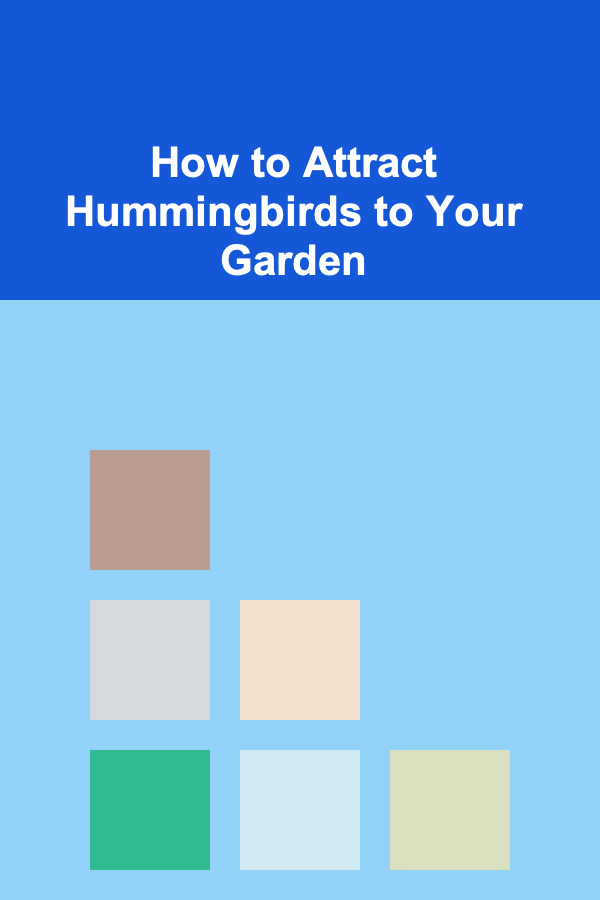
How to Attract Hummingbirds to Your Garden
ebook include PDF & Audio bundle (Micro Guide)
$12.99$11.99
Limited Time Offer! Order within the next:

Hummingbirds are one of nature's most fascinating creatures, known for their tiny size, rapid wing movement, and vivid colors. These birds, often associated with vibrant gardens, play a vital role in pollination, contributing significantly to the health of many flowering plants. If you are a garden enthusiast looking to enhance the biodiversity of your outdoor space, attracting hummingbirds to your garden can be an incredibly rewarding experience.
In this article, we'll explore effective strategies to attract hummingbirds to your garden, focusing on everything from the best types of plants to grow, creating an inviting environment, and maintaining feeders that will ensure your garden remains a hummingbird haven. Whether you're a seasoned gardener or a novice looking to add some life to your outdoor space, this guide will provide you with practical steps and insights to create a hummingbird-friendly garden.
Understanding Hummingbirds
Before diving into how to attract hummingbirds, it's important to understand a few key aspects of these unique creatures. Hummingbirds are small, often weighing less than a nickel, with wings that can beat up to 80 times per second. This incredible flight ability allows them to hover in place while feeding, making them highly efficient pollinators.
There are over 330 species of hummingbirds, with the majority found in the Americas. While they are capable of flying long distances, most hummingbirds are migratory and will travel thousands of miles between their breeding and feeding grounds. These tiny birds are drawn to flowers that produce nectar, which they consume using their long, specialized bills and extendable tongues.
Why Attract Hummingbirds?
Attracting hummingbirds to your garden offers more than just visual beauty. These birds are incredibly beneficial to gardens as they pollinate plants while feeding, which increases the diversity and health of your garden. They also help to control insect populations, as they occasionally eat small insects and spiders for protein.
Creating a welcoming environment for hummingbirds can foster a peaceful, vibrant ecosystem, helping you connect with nature in a meaningful way.
Choosing the Right Plants for Hummingbirds
The most effective way to attract hummingbirds is to plant species they love. Hummingbirds are primarily attracted to flowers that produce nectar, and they have a preference for specific flower colors, shapes, and sizes. Let's explore which plants are best suited for drawing hummingbirds into your garden.
Flower Color Preferences
Hummingbirds are most attracted to red, orange, and pink flowers, as these colors are associated with high nectar-producing blooms. While they can visit flowers of other colors, including blue, purple, and white, they tend to gravitate toward the vibrant hues.
However, it's important to note that the flower's color isn't the only factor that will attract hummingbirds. Flower shape and the availability of nectar are just as critical.
Best Flowers for Hummingbirds
1. Trumpet Vine (Campsis radicans)
The trumpet vine is one of the best plants to attract hummingbirds. Its large, tubular red or orange flowers are filled with nectar, and the shape of the blooms makes it easy for hummingbirds to feed. This fast-growing vine is ideal for covering trellises, fences, and pergolas.
2. Bee Balm (Monarda didyma)
Bee balm, with its bright red, pink, or purple tubular flowers, is another excellent plant for attracting hummingbirds. It's not only beautiful but also an aromatic addition to your garden, providing nectar for both hummingbirds and pollinators like bees.
3. Fuchsia (Fuchsia spp.)
Known for its bright red and purple flowers, fuchsia is another hummingbird favorite. The long, pendulous flowers are perfect for hummingbirds to hover near and feed from. Fuchsia thrives in partially shaded areas, making it suitable for gardens with less direct sunlight.
4. Columbine (Aquilegia spp.)
Columbine flowers come in a variety of colors, including red, pink, purple, and yellow, with tubular blooms that hummingbirds adore. These flowers are ideal for attracting hummingbirds early in the spring and throughout the summer.
5. Salvia (Salvia spp.)
Salvia is a versatile and long-blooming perennial plant that produces dense, tubular flowers in shades of red, purple, or pink. Hummingbirds are drawn to the abundance of nectar, and salvia's long bloom period ensures a continuous food supply.
6. Honeysuckle (Lonicera spp.)
Honeysuckle vines produce clusters of tubular flowers, often in shades of red, orange, or yellow. These fragrant blooms are highly attractive to hummingbirds and also offer a rich source of nectar.
Planting Tips for Hummingbirds
- Group Plants Together: To make your garden even more inviting, group hummingbird-attracting plants together. This arrangement will allow the birds to easily move from one flower to the next without having to fly far.
- Choose Native Plants: Native plants are often the best option for attracting hummingbirds. These species are adapted to local climates and are more likely to provide the nectar that local hummingbirds seek.
- Provide Variety: Incorporate a mix of flowering plants that bloom at different times of the year. By doing so, you'll provide a consistent food source for hummingbirds throughout the seasons.
Setting Up Hummingbird Feeders
In addition to planting nectar-rich flowers, setting up hummingbird feeders is another effective strategy for attracting these birds. Feeders ensure a reliable source of food, especially during migration periods when flowers may not be as abundant.
Choosing the Right Feeder
Hummingbird feeders come in many shapes and sizes, but the key is to choose one that is easy to clean and fill. Some key features to consider include:
- Port Size: Ensure the feeder has appropriately sized ports for hummingbirds to feed from. The holes should be small enough to prevent larger bees and insects from accessing the nectar.
- Ant Moats: Consider a feeder with an ant moat or add one yourself. These small water-filled basins prevent ants from reaching the nectar.
- Red Color: While it's not essential, many hummingbird feeders are designed with red coloring, which mimics the flowers hummingbirds are naturally attracted to.
Filling the Feeder with Nectar
You can make your own hummingbird nectar by mixing one part white granulated sugar with four parts water. Boil the water first to ensure the sugar dissolves completely, and then allow the mixture to cool before filling the feeder. Avoid using honey, artificial sweeteners, or red food coloring, as these can harm the birds.
Placement of Feeders
Place your feeder in a spot that is easy for hummingbirds to find and access. Ideally, it should be positioned near plants that provide cover, such as trees or shrubs, so that the birds feel safe while feeding. Avoid placing the feeder in direct sunlight, as this can cause the nectar to spoil quickly.
Maintaining Clean Feeders
To ensure the health of the hummingbirds, it's essential to clean the feeder regularly. A dirty feeder can harbor mold, which is harmful to the birds. Clean the feeder thoroughly with hot water every 3 to 5 days, and more often in hot weather.
Providing Additional Resources
While nectar is the primary food source for hummingbirds, providing other resources can further encourage these birds to visit your garden.
Water Sources
Hummingbirds need water for drinking and bathing, so consider adding a birdbath or shallow water feature to your garden. Ensure the water is no more than a couple of inches deep, and add rocks or pebbles to allow the birds to perch while drinking.
Shelter and Safety
Hummingbirds need safe places to rest and hide from predators. Planting shrubs, trees, and vines around your garden provides shelter and a place for them to feel secure. Additionally, you can add small birdhouses or natural cover where hummingbirds can take a break and rest between feeding sessions.
Avoiding Pesticides
Hummingbirds are sensitive to pesticides and other chemicals. To create a truly bird-friendly garden, avoid using harmful chemicals that could harm the birds or their food sources. Instead, opt for organic gardening practices and encourage beneficial insects to help control pests.
Observing Hummingbird Behavior
Once your garden begins to attract hummingbirds, take time to observe their behavior. Hummingbirds are territorial creatures and often defend feeding areas from other birds. This fascinating behavior can provide hours of enjoyment as you watch them chase away rivals or interact with one another.
You might also notice that hummingbirds are often in a hurry. Their rapid wing beats and quick movements make them seem like they are constantly on the go. However, by providing them with plenty of food sources and safe spaces to rest, you will help create an environment where they feel comfortable and can thrive.
Conclusion
Attracting hummingbirds to your garden is a rewarding and enjoyable endeavor that can enhance the beauty and biodiversity of your outdoor space. By carefully selecting the right plants, providing feeders, and creating a safe and nurturing environment, you can make your garden a sanctuary for these amazing creatures.
Remember that patience is key---hummingbirds may take time to discover your garden, but with consistent care and attention, you'll soon enjoy the company of these colorful, tiny visitors. Not only will they provide hours of entertainment, but they'll also help improve the health of your garden through pollination, making your efforts even more worthwhile.

How to Build Client Relationships for Long-Term Fitness Coaching Success
Read More
How to Upgrade Your Home's Insulation for Better Comfort
Read More
How to Use a Bunning Carpet Cleaner for Deep Cleaning Your Carpets
Read MoreHow To Use Acoustic Tracking for Marine Animals
Read More
How to Understand the Mental Game of Esports
Read More
How to Foster Independent Learning Skills
Read MoreOther Products

How to Build Client Relationships for Long-Term Fitness Coaching Success
Read More
How to Upgrade Your Home's Insulation for Better Comfort
Read More
How to Use a Bunning Carpet Cleaner for Deep Cleaning Your Carpets
Read MoreHow To Use Acoustic Tracking for Marine Animals
Read More
How to Understand the Mental Game of Esports
Read More